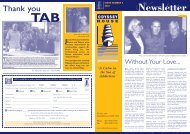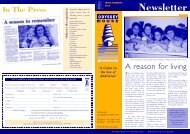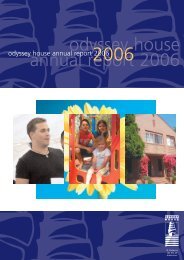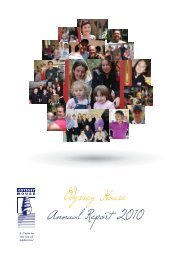ATS Literature Review, Consultations & Trial - Odyssey House
ATS Literature Review, Consultations & Trial - Odyssey House
ATS Literature Review, Consultations & Trial - Odyssey House
Create successful ePaper yourself
Turn your PDF publications into a flip-book with our unique Google optimized e-Paper software.
Amphetamine‐Type Stimulants: Development of a Treatment Protocol<br />
• tolerance, defined as either a need to use larger amounts to achieve desired effect, or<br />
decreased effect with continued use of the same amount of substance;<br />
• withdrawal;<br />
• increased dosage and duration of the substance use;<br />
• unsuccessful attempts to cut down or control substance use;<br />
• increased time spent to obtain the substance, use the drug or come down from the drug;<br />
• giving up social, occupational and recreational activities because of substance use; and<br />
• continued substance use despite knowledge of having an awareness of negative<br />
consequences (e.g., physical or psychological problems) (American Psychiatric Association,<br />
2000)<br />
As with any drug, users of methamphetamine may do so on an occasional, regular or dependent<br />
basis. What constitutes harmful substance use has been the subject of much debate. A traditional<br />
view has been that drug‐related harm is mostly related to drug dependence. While those who are<br />
dependent on substances generally do experience harm, it is now recognised that a wider<br />
perspective needs to be addressed. A useful model highlighting this broader perspective is provided<br />
by Thorley (1982).<br />
1.1 Prevalence: Australia<br />
Intoxication<br />
Regular use Dependence<br />
Figure 1. Thorley’s model of drug harm<br />
The Victorian Amphetamine‐type Stimulants (<strong>ATS</strong>) and Related Drugs Strategy 2007‐2010 Discussion<br />
Paper (2007), notes that while the use of <strong>ATS</strong> in the general community remains low, these drugs are<br />
now the second most commonly used illicit drugs after cannabis.<br />
The 2007 National Drug Strategy <strong>House</strong>hold Survey (2008) reports 7.7% of males (0.7 million) and<br />
4.9% of females (0.4 million) over 14 years of age having tried meth/amphetamine over the course<br />
of their lifetime. Three percent of males and 1.6% of females aged 14 years and over had used<br />
meth/amphetamine for non‐medical purposes in the 12 months prior to the survey. A total of 6.3%<br />
of the general population has used meth/amphetamine. These figures translate to approximately<br />
1.1 million Australians having used meth/amphetamine in their lifetime. Just 2.3% of the population<br />
have used meth/amphetamine in the past 12 months. It is important to note that both recent and<br />
lifetime use of meth/amphetamine has dropped since the 2004 survey. These results are statistically<br />
significant (AIHW, 2008).<br />
Lifetime use of ecstasy is higher than meth/amphetamine use, at 8.9% of the population, and recent<br />
use is 3.5%. Therefore, approximately 1.5 million Australians have used ecstasy at some time in their<br />
life, and approximately 0.6 million have used ecstasy in the past 12 months.<br />
Page 16 © Lynne Magor‐Blatch & James A. Pitts: <strong>Odyssey</strong> <strong>House</strong> McGrath Foundation 2008‐2009








